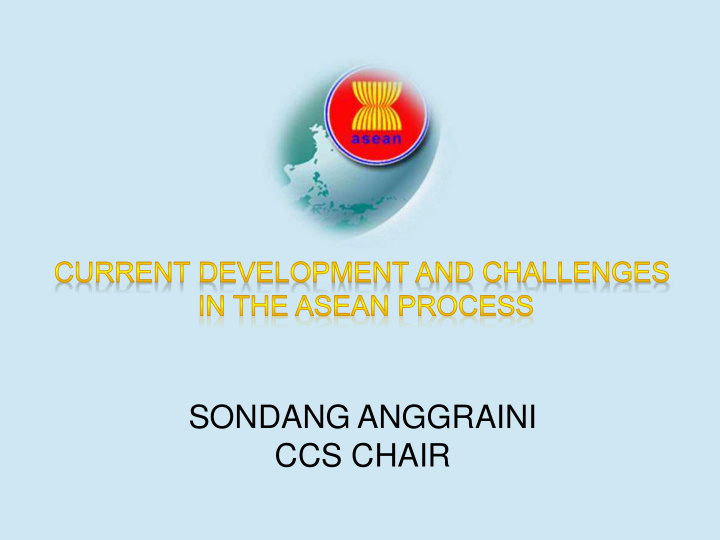



SONDANG ANGGRAINI CCS CHAIR
AFAS Singed in 1995 There are 3 main objectives Enhance cooperation in services amongst member states in order to improve the efficiency and competitiveness, diversify production capacity and supply and distribution of services of firms within and outside ASEAN Substantially eliminate restrictions to trade in services among member states; and Expand the depth and scope of liberalization beyond those undertaken in GATs, with aims to realize free trade areas in services AFAS is a framework agreement and contains several general provisions It is not a self contained agreement, the provisions which guides the implementation of AFAS is based on GATs
AFAS Completion of AFAS Package under CCS, WCFSL and ATSN based on GATs Positive list approach Request and Offer, except under CCS 128 sub-sectors base on roadmap Goals for 128 sub-sectors Market access: mode 1 and mode 2 None and mode 3 FEP 70% National Treatment: mode 1 and 2 None, mode 3 PIS no limitation and others 2 limitation Having difficulties to liberalize some sub-sectors due to domestic regulation in AMS, starting AFAS 8 Flexibility is implemented
DEVELOPMENT OF AFAS Currently ASEAN has completed: Under CCS: AFAS Eight Package (80 sub-sectors) with PIS (29 sub-sectors consist of tourism, e-ASEAN and healthcare services) and just submitted initial offer of Nine Package (including 9 sub-sectors under logistics) and should be finalized by end 2013 Under WCFSL : AFAS seven Package Under ATSN: • At CCS Meeting in Danang May 2011, CCS has negotiated possible elements of the ASEAN TISA among others core obligation, general and specific obligation, Schedule of commitments, general provision and exception, relation with other/related agreements and others.
CHALLENGES ASEAN aims to be an integrated regional economy with a single market and production network in the view to be an active participant in the global value chain AFAS remains as it is agreed in 1995 Starting early 2000, ASEAN engaged in several ASEAN negotiation with several dialogue partners that includes trade in services agreements/chapters: text is more “liberal” than GATs more or less based on request of ASEAN FTAs partners Contains some provisions beyond GATs Commitment is lower than AFAS • AFAS does not have template on financial services, telecommunication and air transport annexes. • ASEAN will embark on negotiation for RCEP
WHAT DO WE WANT TO ACHIEVE Strengthen economic linkages and provide greater opportunities Increase trade and investment, and create large market and greater economies of scale Remove barriers to trade in services and create a predictable environment Establish cooperative framework to further strengthen economic relations between parties promoting and facilitating utilization of the greater opportunities provided by the Agreement promoting regulatory cooperation developing and co-operation in the field of human resource development increasing the participation of the small and medium enterprises in trade and investment activities
WAY FORWARD ASEAN agreement in goods and investment have been transformed to ATIGA and ACIA. The agreements are comprehensive in their scope as well as provisions that are based on international best practices. Ministers tasked the SEOM and its subsidiary body, the CCS at 7 th AEC Council Meeting and the 43 rd AEM Meeting in 2011, to undertake a review of the AFAS with a view towards enhancing ATISA. After a thorough assessment and deliberation on this, the 8 th AEC Council and 44 th AEM Meeting in 2012 mandated the enhancement of AFAS to be finalized by 2015
THANK YOU
Recommend
More recommend